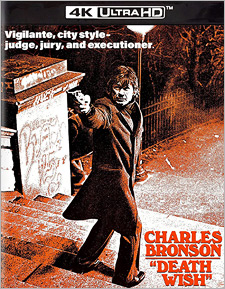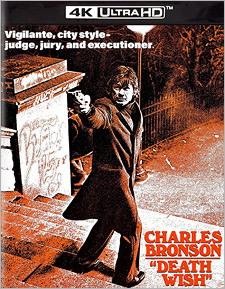Death Wish (1974) (4K UHD Review)

Director
Michael WinnerRelease Date(s)
1974 (January 24, 2023)Studio(s)
Paramount Pictures (Kino Lorber Studio Classics)- Film/Program Grade: B
- Video Grade: A-
- Audio Grade: B
- Extras Grade: B+
Review
Film critics and historians have gone back and forth over the years as to which film made during the 1970s personified the gritty, down-beat turn in American cinema. Most cite 1971’s Dirty Harry as the catalyst, though the argument could also be made for The French Connection, Serpico, and especially 1974’s Death Wish, which not only birthed the vigilante film as we know it, but also gave Charles Bronson his career-defining role. Four sequels, a remake, and a slew of imitators would come in the film’s wake, speaking to a nation of individuals who were continually feeling distrustful of the government and marginalized during the ongoing war in Vietnam. Though the source novel by Brian Garfield didn’t advocate for vigilantism, the film embraced it wholly as the answer to the world’s problems, which spoke to audiences everywhere as a result.
Mild-mannered businessman Paul Kersey (Bronson) lives with his family in New York City and the ever-looming threat of violence on the city streets. One day his wife Joanna (Hope Lange) and his daughter Carol (Kathleen Tolan) are followed home from the grocery store by three muggers, who invade their home and viciously attack them. In the aftermath, Paul is disillusioned by the fact that the perpetrators won’t be caught or punished, and after an intense encounter with a mugger on the street in which Paul fights back and successfully scares him away, he grows braver and braver about going out at night. After receiving a revolver as a gift from a client, Paul secretly takes to streets, taking out muggers one by one, but as police inspector Ochoa (Vincent Gardenia) gets closer to discovering who’s behind these shootings, the threat of Paul becoming a martyr and causing a wave of uncontrollable vigilantism becomes an ever-increasing reality.
Though the sequels to Death Wish, particularly Death Wish III, would get sillier and more over-the-top, the original film and its sequel are particularly nasty, but very well made. The violence against the two women is definitely hard to take, though it’s no match for the uncut version of Death Wish II, which this reviewer finds overly detestable and highly unnecessary. However, it does serve a purpose. We as an audience are now rooting for Bronson to blow the bad guys away, which offers some catharsis for the horrors of real life wherein the bad guys evade the authorities, or the justice system sees fit to go lenient on them. It’s satisfying a psychological urge of sorts for revenge, even though many would argue that violence is never the answer.
Death Wish also carries a cast of surprisingly familiar faces from the top of the roster down. They include Steven Keats, Stephen Elliott, Saul Rubinek, John Herzfeld, Jeff Goldblum, Olympia Dukakis, Al Lewis, Paul Dooley, Christopher Guest, and Billy Curtis. Some go uncredited in the final film, but it’s interesting that there are so many notable names in the cast. As for the film’s director, Michael Winner, he had already worked with Bronson on Chato’s Land, The Mechanic, and The Stone Killer the previous couple of years, and would continue to work with him on the first pair of Death Wish sequels. The two would become synonymous with each other, though Bronson would also become synonymous with director J. Lee Thompson, who worked with him on Death Wish IV: The Crackdown, as well as 10 to Midnight, The Evil That Men Do, St. Ives, The White Buffalo, and many others.
Death Wish was remade in 2018 by Eli Roth, with Bruce Willis taking over the role of Paul Kersey. The results were mixed, but it did nothing to tarnish the legacy of the original film. Like many New York films of the 1970s, it’s also a snapshot of an era before the city became something else entirely.
Death Wish was shot by cinematographer Arthur J. Ornitz on 35 mm film using Panavision PSR R-200° cameras and spherical lenses, finished photochemically, and presented in the aspect ratio of 1.85:1. Kino Lorber Studio Classics brings the film to Ultra HD with a new master derived from a 4K scan of the original camera negative, graded for High Dynamic Range (HDR10 and Dolby Vision options are included), and presented on a triple-layered UHD100 disc. It’s an organic presentation, and definitely the best the film has ever looked on home video. The opening credits are the roughest section as they were likely pulled from a lower quality interpositive, but once they conclude, the image smooths out with a bitrate that sits between 70 and 80mbps. Mild speckling is present throughout, though the presentation is otherwise clean. Grain isn’t quite as obvious as other restorations of films from this time period, but neither does it look noisy or unnatural. The HDR grades deepen detail in the palette somewhat, though not dramatically so. Contrast wavers slightly as blacks tend to flatten occasionally, but for the most part, shadow detail is ideal in some of the more darkened environments. It’s definitely a fine upgrade and looks spectacular in motion quite often.
Audio is included in English 2.0 mono and 5.1 DTS-HD Master Audio with optional subtitles in English SDH. The film was originally released in standard mono, while the new 5.1 track offered here gives the soundtrack some added teeth in regards to environmental ambience. Dialogue on both tracks is reserved but discernible. And Herbie Hancock’s score has plenty of weight to it.
Death Wish on Ultra HD sits in a black amaray case alongside a 1080p Blu-ray with an insert that features the original US theatrical artwork on one side and the Italian poster artwork with English text on the reverse. Everything is housed in a slipcover featuring the same US theatrical artwork. The following extras are included on each disc:
DISC ONE (UHD)
- Audio Commentary by Paul Talbot
DISC TWO (BD)
- Audio Commentary by Paul Talbot
- John Herzfeld on Death Wish (HD – 18:24)
- Radio Spots (HD – 2 in all – 1:31)
- TV Spot (HD – 1:03)
- Trailer (HD – 2:20)
- Violent City Trailer (HD – 3:54)
- Cold Sweat Trailer (SD – 2:36)
- Chato’s Land Trailer (HD – 2:10)
- The Valachi Papers Trailer (Upscaled SD – 3:23)
- Mr. Majestyk Trailer (SD – 1:33)
- Breakout Trailer (HD – 1:34)
- Breakheart Pass Trailer (SD – 3:07)
- The White Buffalo Trailer (HD – 1:52)
- Cabo Blanco Trailer (HD – 2:49)
- Murphy’s Law Trailer (SD – 1:30)
In the audio commentary with Paul Talbot, author of the Bronson’s Loose! and Bronson’s Loose Again!, he provides a very detailed background on the film, including the fact that it was almost made at Universal with Sidney Lumet, while also going into the careers of the main cast and crew, particularly Charles Bronson and Michael Winner. He also details scenes deleted or never filmed, and also discusses the real life violence that was occurring in New York City at that time. Like other tracks that he’s provided for other Charles Bronson films, it’s an informative and invaluable listen. In a Skype/Zoom interview with actor John Herzfeld, he discusses being a young starving actor, reading for the film (mentioning that he worked with Denzel Washington, which the actor has denied), pursuing his acting career from a young age, working with Michael Winner and Charles Bronson, the impact that Spartacus had on him and his father, his friend Sylvester Stallone playing a mugger in Bananas around the same time, appearing in Serpico, and his final thoughts on the film. There’s also a pair of US and UK radio spots, a TV spot, the film’s trailer, and trailers for other Charles Bronson films releases by Kino Lorber on Blu-ray.
Death Wish continues to hold up as a very effective thriller with a great performance by Charles Bronson and aggressive direction by Michael Winner (as if Winner was capable of any other kind of direction). Kino’s 4K Ultra HD release is most definitely a step up in terms of quality. Long-time fans should be pleased with it. Highly recommended.
- Tim Salmons
(You can follow Tim on social media at these links: Twitter and Facebook. And be sure to subscribe to his YouTube channel here.)

